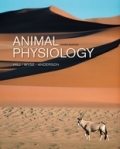
Animal Physiology. presents all the branches of modern animal physiology witha strong emphasis on integration of physiological knowledge, ecology, and evolutionary biology. Integration extends from molecules to organ systems and from one physiological discipline to another. The book takes an entirely fresh approach to each topic. Its full-colour illustrations include many novel, visually effective features to help students learn. Each of the 25 main chapters starts with a brief animal example to engage student interest and demonstrate thevalue of the material that will be learned. The book includes five additional, briefer 'At Work' chapters that apply students' newfound physiological knowledge to curiosity-provoking and important topics, including diving by marine mammals, the mechanisms of navigation, and muscle plasticity in use and disuse.The book is committed to a comparative approach throughout. Whereas mammalianphysiology is consistently treated in depth, emphasis is also given to the other vertebrate groups, arthropods, molluscs, and as appropriate additional invertebrates. Concepts and integrative themes are emphasized while giving students the specifics they need. The whole animal is the principal focus of this book. The pages are filled with information on everything from knockout mice, genomics, and enzyme chemistry to traditional organ physiology, phylogenetic analysis, and applications to human affairs. Always, the central organizing principle for the array of topics presented is to understand whole animals in the environments where they live. Complex principles are developed clearly and carefully to help students understand important concepts in sufficient depth without being overwhelmed. Pedagogical aids include embedded summaries throughout chapters, study questions, partially annotated reference lists, an extensive glossary, appendices, and an upgraded index. For all three authors, teaching physiology to undergraduate students has been a lifelong priority. The opening five chapters provide background material on physiological basics, cell-molecular concepts, genomics, physiological development, transport of solutes and water, ecology, and evolutionary biology. The remaining chapters are organized into five sections: Food, Energy, and Temperature . Integrating Systems . Movement and Muscle . Oxygen, Carbon Dioxide, and Internal Transport . Water, Salts, and Excretion. The new edition features:. A new chapter on physiological development and epigenetics (Chapter 4) . An entirely rewritten chapter on sensory processes, integrating latest research insights with organ-system physiology (Chapter 14) . Extensive rewriting, reorganization, or expansion of chapters onaerobic and anaerobic metabolism (Chapter 8), activity energetics (Chapter 9), thermal relations (Chapter 10), osmoregulation (Chapter 28), and kidney function (Chapter 29) . More than 57 new figures or tables . New boxes written by expert guest authors on topics such as fMRI, magnetoreceptors in navigation, optogenetics, sleep, and symbiosis . All chapters updated based on the latest literature and terminology . All figures and text revised as needed for pedagogical effectiveness . Updated, in-depth lists of references to the scientific literature . INDICE: PART I: FUNDAMENTALS OF PHYSIOLOGY.Animals and Environments: Function on the Ecological Stage .Molecules and Cells in Animal Physiology .Genomics, Proteomics, and Related Approaches to Physiology .Physiological Developmentand Epigenetics .Transport of Solutes and Water .PART II: FOOD, ENERGY, AND TEMPERATURE.Nutrition, Feeding, and Digestion .Energy Metabolism .Aerobic and Anaerobic Forms of Metabolism .The Energetics of Aerobic Activity .Thermal Relations .Food, Energy, and Temperature at Work: The Lives of Mammals in Frigid Places .PART III: INTEGRATING SYSTEMS.Neurons .Synapses .Sensory Processes .Nervous System Organization and Biological Clocks .Endocrine and Neuroendocrine Physiology .Reproduction.Integrating Systems at Work: Animal Navigation .PART IV: MOVEMENT AND MUSCLE.Control of Movement: The Motor Bases of Animal Behavior.Muscle .Movement and Muscle at Work: Plasticity in Response to Use and Disuse .PART V: OXYGEN, CARBON DIOXIDE, AND INTERNAL TRANSPORT.Introduction to Oxygen and Carbon Dioxide Physiology .External Respiration: The Physiology of Breathing .Transport of Oxygen and Carbon Dioxide in Body Fluids - With an Introduction to Acid-Base Physiology .Circulation .Oxygen, Carbon Dioxide, and Internal Transport at Work: Diving by Marine Mammals .PART VI: WATER, SALTS, AND EXCRETION.Water and Salt Physiology: Introduction and Mechanisms .Water and Salt Physiology of Animals in Their Environments .Kidneys and Excretion - With Notes on Nitrogen Excretion .Water, Salts, and Excretion at Work: Mammals of Deserts and Dry Savannas .Appendices.Additional References.Glossary.Photo Credits.Figure and Table Citations.Index .
- ISBN: 978-0-87893-662-5
- Editorial: Sinauer
- Encuadernacion: Cartoné
- Páginas: 725
- Fecha Publicación: 23/06/2012
- Nº Volúmenes: 1
- Idioma: Desconocido
